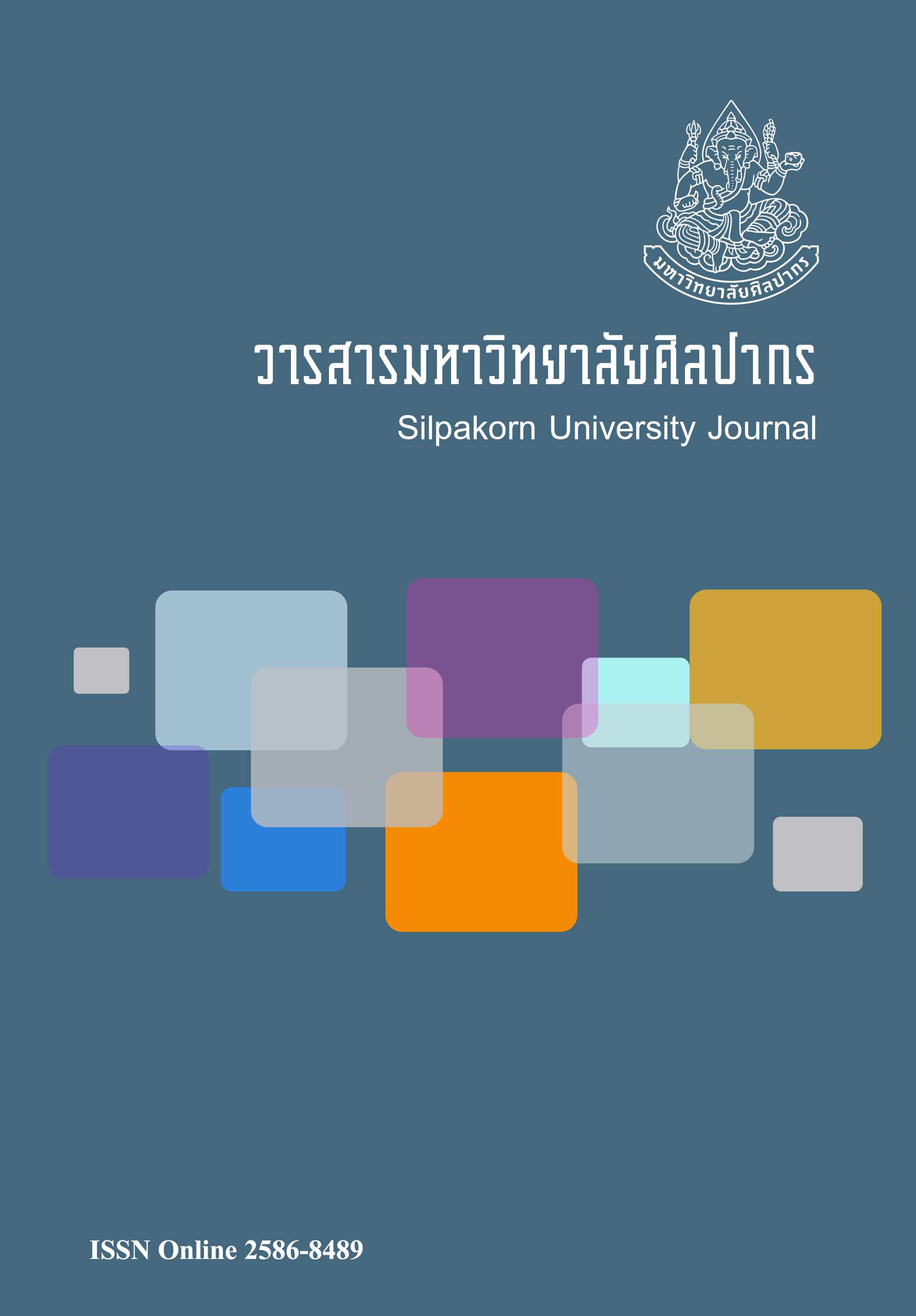รูปแบบการจัดการธนาคารความดีเพื่อเสริมสร้างความอยู่เย็นเป็นสุขและการเปลี่ยนผ่านการเรียนรู้เชิงสร้างสรรค์ด้วยการจัดการตนเอง (Goodness bank management model for happiness promotion and transformation through creative learning by self-management)
Main Article Content
Abstract
การวิจัยครั้งนี้ เป็นการวิจัยและพัฒนา มีวัตถุประสงค์การวิจัยเพื่อ 1) ศึกษาสภาพการณ์ในการดำเนินงานธนาคารความดีของชุมชนบ้านหัวง้ม จังหวัดเชียงราย และชุมชนบ้านหนองสาหร่าย จังหวัดกาญจนบุรี 2) ถอดบทเรียนการดำเนินการธนาคารความดี 3) ศึกษาแนวทางการดำเนินงานธนาคารความดี และ 4) สังเคราะห์รูปแบบการจัดการธนาคารความดีเพื่อเสริมสร้างความอยู่เย็นเป็นสุขและการเปลี่ยนผ่านการเรียนรู้เชิงสร้างสรรค์ด้วยการจัดการตนเองของชุมชนจังหวัดกาญจนบุรี ดำเนินการวิจัย 4 ขั้นตอน คือ ขั้นตอนที่ 1 ศึกษาข้อมูลพื้นฐาน ขั้นตอนที่ 2 ถอดบทเรียน ขั้นตอนที่ 3 ศึกษาแนวทางการดำเนินงาน และขั้นตอนที่ 4 สังเคราะห์รูปแบบ กลุ่มเป้าหมาย 20 คน ใช้การเลือกแบบเจาะจง ผู้ทรงคุณวุฒิ 5 คน เครื่องมือที่ใช้เป็นการวิเคราะห์เอกสาร แนวทางการสัมภาษณ์เชิงลึก แนวทางการสนทนากลุ่ม และการสังเกตแบบไม่มีส่วนร่วม รวบรวมข้อมูลและวิเคราะห์ข้อมูลด้วยการวิเคราะห์อุปนัย และถอดบทเรียนแบบ AAR ผลการวิจัย พบว่า 1) พื้นที่ที่ศึกษาได้ดำเนินการมา 10 ปี มีการกำหนดเกณฑ์การทำความดี มีโครงการและกิจกรรมที่หลากหลายตามภูมิสังคม ชุมชนมีศักยภาพและความเข้มแข็ง 2) การถอดบทเรียนพบปัจจัยความสำเร็จของจตุรภาคี ได้แก่ ภาครัฐ เอกชน องค์กรและชุมชน ผู้บริหารมีวิสัยทัศน์ ความไว้วางใจ เสียสละ ทุ่มเท สมาชิกมีส่วนร่วมในกิจกรรมต่างๆ และ จิตสาธารณะ มีการปฏิบัติที่เป็นเลิศ ได้แก่ การมีทุนทางสังคม แผนชุมชน สภา 79 โรงเรียนผู้สูงอายุและสถาบันการเงินชุมชนมีการลดรายจ่าย เพิ่มรายได้ เน้นการออม 3) แนวทางการพัฒนาธนาคารความดี ได้แก่ ควรมีการสร้างแม่ข่าย-ลูกข่าย ความร่วมมือของทุกภาคส่วน การกำหนดเป้าหมายร่วมกัน การแบ่งงานกันทำตามความสนใจในอาชีพเสริม ระบบเครือญาติช่วยเสริมในการจัดการ สร้างการเรียนรู้เชิงสร้างสรรค์ร่วมกันของชุมชน การมีวิสัยทัศน์ และยอมรับผู้นำ ชุมชนมีการจัดการตนเอง มีจิตสำนึกในการทำความดี และ 4) รูปแบบธนาคารความดีชื่อว่า “GOODNESS Model” มีองค์ประกอบย่อย ได้แก่ 1) G = Goal to Success (เป้าหมายความสำเร็จ) 2) O = Organizing Management (การจัดองค์กร) 3) O = Operation (การปฏิบัติการ) 4) D = Differentiation (การเปลี่ยนแปลง) 5) N = Network Building (การสร้างเครือข่าย) 6) E = Ethics (คุณธรรม จริยธรรม) 7) Self- Management (การจัดการตนเอง) 8) S = Sustainability (ความยั่งยืน) ซึ่งได้ผ่านการรับรองรูปแบบ
This research and development program aims to: 1) study goodness banks actuation; 2) investigate the lesson learnt from goodness banks in the Hua-Ngom community, Chiangrai Province, and Nong-Sarai community, Kanchanaburi Province; 3) identify the approaches to goodness bank operation; and 4) synthesize the model of goodness bank to promote happiness and transformation through creative learning by self-management of Kanchanaburi Province community. The research process consisted of 4 stages as follows: 1) study basic information about the situation and operation, 2) investigate the lesson learnt, 3) study the approaches to the operation, and 4) synthesize the model. Twenty respondents were purposively selected for the focus group discussion and the five experts were next invited for the in-depth interview. The research instruments documentary analysis, in-depth interview, focus group discussion and non-participant observation. The collected data was then analyzed, using Inductive Approach, and the lesson learnt was investigated, using the After Action Review (AAR) technique. The results were as follows. 1) The two goodness banks have continuously been operated for 10 years. They set up the protocol for goodness practice and they organized various activities according to their social landscapes. The communities had strong potentials and strengths. 2) Regarding the lesson learnt, there were successful factors of four parties: state sector, private sector, local organizations and community. Leaders needed to have vision, trust, sacrifice and dedication. The community members needed to have their public mind and participation in the activities. Best practices comprised social capitals, community plans, 79 council, schools of aging group and financial institutions in the community which reduced spending, increased revenue and emphasized saving. 3) Approaches to goodness bank development included the establishment of host-client network, collaboration of all sectors, shared goals, workforce division based on supplementary job interests of community members, familial system to support the operation, collaborative and creative learning of community, vision, leadership recognition, community self-management and public consciousness.3) The model of goodness bank was titled “GOODNESS MODEL”, which is the acronym of its elements: 1) G = Goal to Success, 2) O = Organizing and Management, 3) O = Operation, 4) D = Differentiation, 5) N = Network Building, 6) E = Ethics, 7) S = Self-Management, and 8) S = Sustainability. The model were already certified.
Downloads
Article Details
References
Best, J. and Kahn, J. V. (2006). Research in education. 10th Boston: Pearson Education Inc.
Cavusgil S. T., Calantone R.J. and Zhao C.Y. (2003). Tacit knowledge transfer and firm innovation capability. Journal of Business & Industrial Marketing, 18(1): 6-21.
Keeves J.P. (1988). Educational research, and methodology, and measurement. An International Handbook. Oxford: Pergamon Press.
Roamratanapun V. (2005). Social Capital (ทุนทางสังคม). Bangkok: Project on Learning Support for Happiness Community.
Scott, C.D. and Jeffe D.T. (1991). Empowerment : Building a committed workforce. California: Kojen Page.
Steven, Dickinson. (2002). Police Ethics Training : Is it enough?. Fiorida: West Palm Beach.
Sungrugsa, N. (2011). Benchmarking & Best Practice : New Concept in Research for Social Quality Development (Benchmarking & Best Practice : แนวคิด ใหม่ในการวิจัยเพื่อพัฒนาคุณภาพสังคม). Educational Journal, Silpakorn University, 9(1): 91-106.
Sungrugsa, N. (2012). Lesson learned : Technique Approach used to Learning for Development Community (การถอดบทเรียน : เทคนิควิธีการเรียนรู้บทเรียน เพื่อการพัฒนาชุมชน). Education Journal, Silpakorn University, 9(2): 18-33.
Sungrugsa, N. and Unaromleart T. (2007). A Lesson Learnt from Progressive Sufficiency Economic Activities on Integrated Learning Processes of Community Enterprises for Green and Happiness Society in Ratchaburi Province (ถอดบทเรียนกระบวนการเรียนรู้บูรณาการ กิจกรรมทางเศรษฐกิจพอเพียงแบบก้าวหน้าของวิสาหกิจชุมชน เพื่อสังคมอยู่เย็นเป็นสุขในจังหวัดราชบุรี). Bangkok: National Research Council of Thailand.
Sungrugsa, N., Unaromlerd, T., Paiwittayasiritham, C. and Janpla, J. (2011). The Synthesis and Lesson Learnt on Decencies Learning Camps toward Sufficiency Life Project, Year 2007-2010 (การสังเคราะห์และถอดบท เรียนโครงการค่ายเรียนรู้คุณธรรมนำชีวิตพอเพียง ปี 2550-2553). Bangkok: Office of the Higher Education Commission : OHEC.
Sungrugsa, N. and Lukhananuluk, S. (2012). Research for Development and Changing in Cultural Tourism toward Creative Economy through Participation Process of Sustainable Network Alliances in Ratchaburi Province (การวิจัยเพื่อพัฒนาและยกระดับการท่องเที่ยวเชิงวัฒนธรรม สู่เศรษฐกิจสร้างสรรค์ผ่านกระบวนการมีส่วนร่วมของภาคีเครือข่ายอย่างยั่งยืนในจังหวัดราชบุรี). Bangkok: National Research Council of Thailand.


